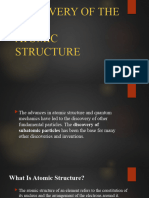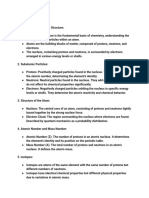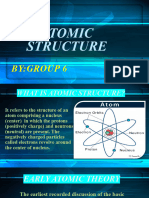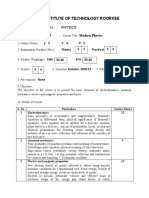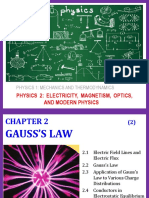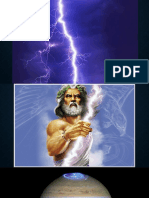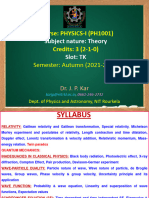Here’s the extended version of the first lecture note on *Atomic Structure*.
---
**Lecture 1: Atomic Structure**
In this extended lecture, we delve deeply into the concept of atomic structure, which
forms the foundation of chemistry and material science. The atom, considered the
smallest indivisible unit of matter, comprises a central nucleus surrounded by a cloud
of electrons. The nucleus, a dense core, contains positively charged protons and
neutral neutrons, whose numbers define the atomic number and mass number of an
atom, respectively. The arrangement and behavior of electrons around the nucleus are
key in determining an atom’s chemical properties, influencing how atoms bond and
interact with each other.
Early atomic theories began with Dalton, who proposed that atoms were indivisible
particles, distinct for each element. This understanding evolved as J.J. Thomson’s
discovery of the electron suggested atoms were divisible and composed of smaller
particles. Thomson’s “plum pudding” model described the atom as a sphere of positive
charge with embedded electrons. However, this model was soon challenged by
Rutherford’s gold foil experiment, which provided evidence of a dense central nucleus
surrounded by mostly empty space. This led to the Rutherford model, suggesting that
electrons orbit around a positively charged nucleus.
Niels Bohr refined this model by proposing that electrons move in quantized orbits, with
only certain energy levels being allowed. Bohr's model helped explain spectral lines
observed in atomic emission and absorption spectra, which had puzzled scientists.
However, as more experimental data accumulated, it became clear that a more
sophisticated model was needed. The advent of quantum mechanics transformed our
understanding of atomic structure.
Quantum mechanics describes electrons as having both particle and wave properties,
a duality that traditional models could not account for. Schrödinger’s wave equation
and Heisenberg’s uncertainty principle provided a framework for this behavior, revealing
that instead of fixed orbits, electrons occupy probabilistic orbitals — regions where
�electrons are likely to be found. These orbitals have distinct shapes and sizes, typically
classified as s, p, d, and f orbitals. The probability distributions of these orbitals and
their arrangement in shells help determine the chemical properties of each atom.
Electron configuration, or the arrangement of electrons in these orbitals, dictates how
atoms bond with each other, and elements with similar electron configurations tend to
have similar chemical behaviors, forming the basis of the periodic table’s organization.
In addition to this theoretical understanding, spectroscopy offers a practical window
into atomic structure. When atoms absorb or emit light, their electrons jump between
energy levels, producing a spectrum unique to each element. These spectral lines serve
as atomic fingerprints and are widely used in applications ranging from astrophysics to
chemical analysis. For example, by analyzing the light emitted from distant stars,
scientists can determine the elements present in those stars.
The study of atomic structure has advanced dramatically with the development of new
technologies and theories, impacting fields far beyond chemistry. Modern applications
of atomic theory include nanotechnology, quantum computing, and nuclear energy.
Nanotechnology relies on manipulating individual atoms to create new materials with
unique properties. Quantum computing, an emerging field, seeks to harness the
principles of quantum mechanics, such as superposition and entanglement, to perform
complex calculations at unprecedented speeds. In nuclear physics, understanding
atomic nuclei and their energy dynamics allows for the production of energy in nuclear
reactors and has implications for fields like medicine, where isotopes are used in
diagnostic imaging and cancer treatment.
Atomic structure remains a rich area of study, with ongoing research continually refining
our understanding of matter at its most fundamental level.





























